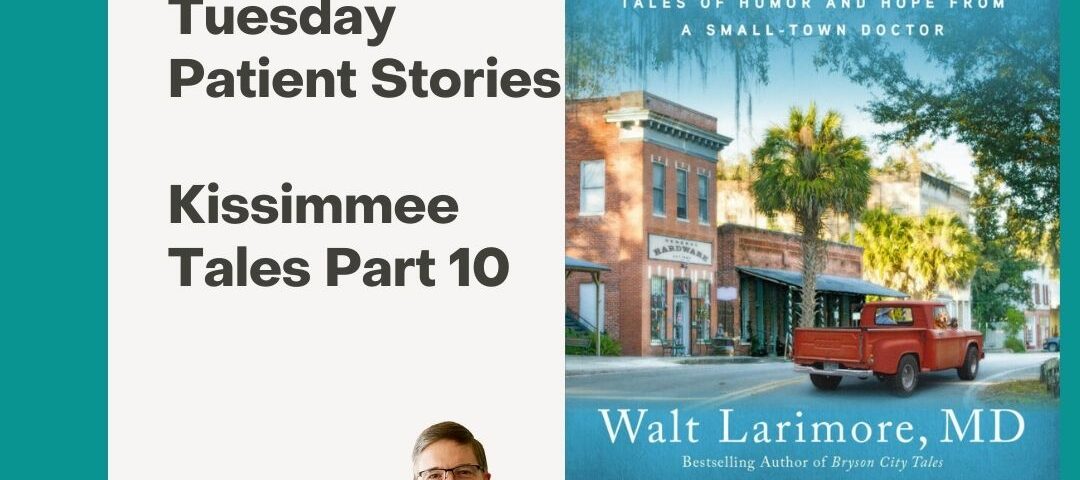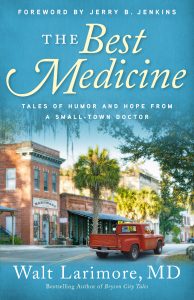
Smoking, drinking, high BMI linked to almost half of all cancer deaths
October 10, 2022
Early risers — who also stay busy — benefit from a better mood and mind
October 12, 2022For the next few months, I’m excerpting chapters from the first of two books about my early years in family medicine in Kissimmee, Florida – The Best Medicine: Tales of Humor and Hope from a Small-Town Doctor. I hope you, your family, and your friends will follow along and enjoy this trip back into the past with me and my family.
CHAPTER 7A – FIRST CALL
Dr. John Hartman and I rotated night and weekend calls with two other family physicians who had served with John in the navy. The guys were kind enough to let me settle into office practice for a week before having my first night on call.
After dinner, while Barb was putting Scott to bed with a story and prayer time, I was helping Kate into her pajamas. She had been born with cerebral palsy—think of a baby in the womb having a stroke and losing blood supply to part of the brain. It left her with minimal right brain tissue and only about half of her left brain. Yet, through the years, with much love, prayer, intense therapy, and multiple surgeries, Kate could now walk without braces. She was mainstreamed into regular instead of special needs classes at school and proved to be a quick learner, an avid reader, and an excellent student. As I tucked Kate into bed, my beeper vibrated. It was the ER notifying me I had a patient to see ASAP. I kissed everyone goodnight, not knowing how long I would be away from home.
At the stop sign closest to the hospital, I was sure to come to a full stop. As I pulled forward, I saw a blink of headlights from a vehicle in the shadows of a building across the street. The cab lights of the Kissimmee Police cruiser turned on, and Gib’s smile beamed as he waved.
Only three cars occupied the doctors’ parking lot, but the ER waiting room was overflowing. Ken Byerly was at the doctors’ station and stood to greet me. “So sorry to call you in, Walt. A patient of Dr. Hartman’s has a deep arm laceration. Normally, I’d just sew it up for you guys and not bother you, but I’m too packed tonight. Do you mind helping me out?”
“Not a problem. Glad to.”
“Not me!” boomed a voice behind us. Walking in, dressed in scrubs, sporting a 9:00 p.m. facial shadow and a half-smoked cigarette hanging from his mouth, Frank Crespo wrapped his massive arms around each of our shoulders—Ken on one side, me on the other. “Gotta go to the OR and save lives.”
Judy Simpson, serving that night as the ER charge nurse, walked by. “You may be saving lives, Dr. Crespo, but you cannot smoke in my emergency room.”
Frank muttered, “Mrs. Simpson, I’ll smoke any blankety-blank place I want to. Am I right, Dr. Byerly?”
Judy walked over and jerked the cigarette out of Frank’s mouth. “Any blankety-blank place except my ER, Dr. Crespo.” She strode out the back door to dispose of the butt.
“I wouldn’t recommend riling up my nurse, Frank,” cautioned Ken.
“You should advise her not to rile me up. You know I’m Cuban, and I can use voodoo to put some juju on her.” He hurried out of the ER, a trail of tobacco smoke and fumes swirling behind him.
“Juju?” I asked.
“I think it’s something the Cuban Santería priests or witch doctors do.”
“Santería?”
“A religion that developed in Cuba among West African descendants. Some Cubans in South Florida practice it and mix in animal sacrifice and voodoo. At one of our ER conferences, I heard a talk from Dade County’s chief deputy medical examiner, who is an expert on Santería. He said the cult is flourishing with thousands practicing it—both black magic and white magic sects—whatever that means.”
“I’m not sure I want to find out,” I replied.
“Dr. Byerly, our patient in the trauma room is coding!” yelled Judy.
“Need help?” I asked.
“I’ll let you know!” Ken said as he raced to the room, and Dolly called the code over the intercom.
After changing into surgical scrubs, I looked over the chart, learning my patient was a teenage boy whose horse had thrown him on the family ranch. His arm smashed against a sharp piece of the metal siding of a shed and cut it to the bone. I went in to see him and meet the family. After introductions, I took off the compression dressing. Although the wound was deep, it was clean, and there were no lacerated nerves, vessels, or tendons. I’d have to close it in several layers, and it would take a while, but I assured the boy and family that I expected uncomplicated healing.
Judy stepped out of the trauma room. “The code team has it under control. Can I assist you?”
Together, we numbed and scrubbed the wound before I sewed it closed with over sixty stitches. Judy dressed the wound, while I finished the chart at the doctors’ station, ordered tetanus and antibiotic shots, wrote prescriptions for an oral antibiotic and pain medication, and completed instructions for wound care and follow-up.
“I checked on Ken,” Judy said. “He and the code team were still working on the patient. They successfully resuscitated him and are stabilizing him before transfer to the ICU.”
“Should I offer to help?”
“They’re fine, but I need you to see another of Dr. Hartman’s patients, if you would.” I could tell her request was urgent.
TO BE CONTINUED
This excerpt of The Best Medicine: Tales of Humor and Hope from a Small-Town Doctor is provided with the permission of the publisher Baker/Revell. You can learn more about the book or purchase a copy here.
© Copyright WLL, INC. 2022.



